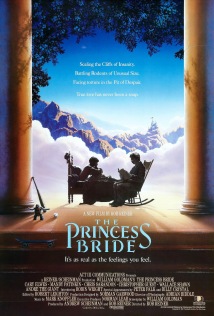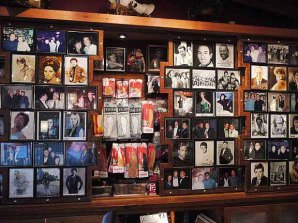A lighter entry for the holiday season! Hollywood Sapien is supposed to be an anthropologist’s eye on the entertainment industry. But I’ve also been a fencing coach for twenty years, and a fencer for almost twenty-five; so this week, it’s a fencer’s eye on the entertainment industry instead. Featuring a highly biased selection of the greatest swordfights on screen. There are plenty of other greats, but these are personal favorites.
Other than the first, they are presented in no particular order. Enjoy! And keep your eyes peeled for the next Sapien entry, on the amazing world of headshots.
1)The Princess Bride
Inigo Montoya (Mandy Patinkin) vs. Wesley (Cary Elwes). Hands-down the greatest sword fight ever filmed (though in William Goldman’s script this is specifically called “the second greatest swordfight ever”). It used to be considered gauche to say this was the best sword duel ever filmed; it was critically assumed that you had to list a fight from a classic movie as the greatest, not one from an 80s comedy. But this one truly has it all – it’s exciting and acrobatic, has plot twists all its own, and a dynamism seen in the best screen duels: the pacing and tempo ebb and flow.
2.)Scaramouche
Scaramouche/Andre Moreau (Stewart Granger) vs. de Maynes (Mel Ferrer). A classic, and deservedly so. For many years, this 8-minute long fencing match was the longest sword duel ever put to screen (and it may still be). This is a swordfight of the classic costume picture era, and it shows. Dazzling sets, sumptuous costumes, and some excellent stunt work make for a great duel. And having watched the main character practice his fencing throughout the movie, it really feels like a culmination of the story; like an epic swordfight is really the only way the movie could end.
3)Ladyhawke
Etienne of Navarre (Rutger Hauer) vs. Marquet (Ken Hutchison). An often-overlooked film duel, this is one of the greats. It starts as a sword fight on horseback, and degenerates (realistically, for a movie) into an on-the-ground brawl, beginning with the opponents clear hatred of each other, and finishing with two exhausted fighters just swinging away with whatever they’ve got left. It’s the sword fight version of the alley brawl in They Live, and it’s great for the same reasons; two big guys smashing away at each other, getting tired but still giving it their all. (also, see note at the end about the music).
4)Robin Hood (1922 version)
Robin Hood (Douglas Fairbanks) vs. the Entire Palace Guard (lots of extras). Douglas Fairbanks was a longtime fencer, and his passion for the sword shows in this picture. Robin’s fight with roughly 20 palace guardsmen is fantastic, and originated many things that later became clichés of the genre – fighting two guys at once with a sword in each hand, fighting an entire squad of guards and singlehandedly pushing them back – it’s the best. Plus, there’s a great pre-fight with Guy of Guisborne (Paul Dickey) in which Robin opens the fight by throwing his hat in Guys’ face, then just goes to town and chokes him like a baseball bat, before breaking him over a piece of furniture. Then Robin grabs a sword and goes after the guards.
5)Rob Roy
Rob Roy McGregor (Liam Neeson) vs. Archibald Cunningham (Tim Roth). What’s particularly great about this fight is that it unfolds the way a battle between two men with these particular weapons (a Scottish broadsword and a rapier) would actually have occurred. The guy with the rapier is much quicker, and dances around his opponent, slashing him to bits. In fact, it’s only the cockiness of the villain that insures his destruction, when Rob Roy grabs the lighter blade, ignoring the pain, and delivers the kind of final stroke you can only get from a good broadsword.
And, like all good DVDs, we’ll add one special bonus, deleted scene:
6)Better Off Dead
Lane Meyer (John Cusack) vs. Ricky Smith (Daniel Schneider). You’ve just skied the infamous K-12, and beaten the stuck-up and overtly ubermensch captain of the ski team, Roy Stalin. You’ve escaped the paperboy, to whom you owe two dollars. And your dreamgirl, French foreign exchange student Monique, is on your arm. But one dastardly rogue stands in your way: skeevy neighbor Ricky, who wants the girl for himself. Ski poles are drawn; only one man can emerge the victor.
— Scott Frank
- Note: it’s true, there are no lightsaber duels listed here. You know why? Lightsabers aren’t swords. It’s not that their blades are energy or anything, it’s that they have no handguards. To stop the blade from sliding down and cutting off your hand. A handguard is one of the basic parts of a sword; without one, you’re not holding a sword, you’re holding a glorified club. (and yes, the ski poles in Better Off Dead don’t really count either – but it’s one of the greatest comedies of the 80s, it gets a free pass).
- Another note: there are no actual fencing (i.e. the sport) movies here. Good reason for that; first of all, there aren’t many, and secondly, the few that do exist are generally really, really terrible. But if you must…check out Ring of Steel (a favorite, ultra-cheesy classic) and By The Sword (Eric Roberts as a fencing master). Also, I’d be remiss to somehow skip Grace Kelly fencing in The Swan.
- Ladyhawke takes a lot of heat from genre lovers, who particularly hate the 80s-new wave soundtrack; usually they say that 1980s music doesn’t fit the time period. They’d apparently prefer an orchestral score or classical music, which anachronistically doesn’t make much more sense – those forms of music mostly came about in the 1750s or later; the movie takes place in the 1200s. So is music 500 years out of date better than music 700 years out of date?









